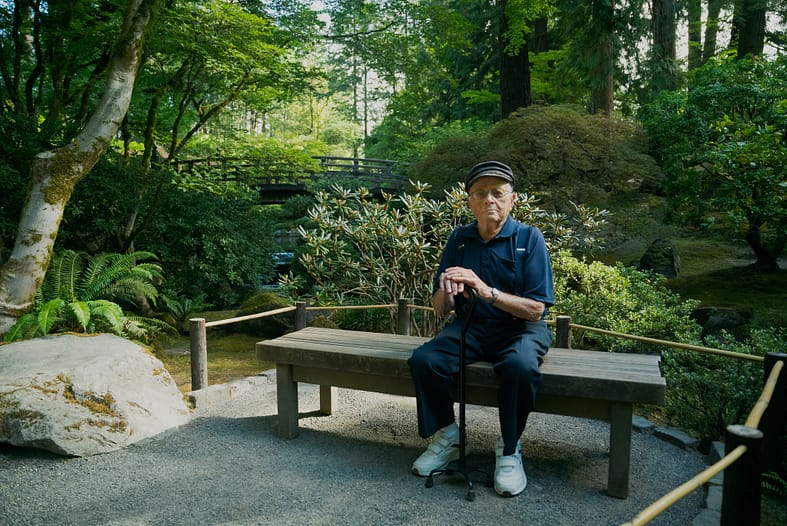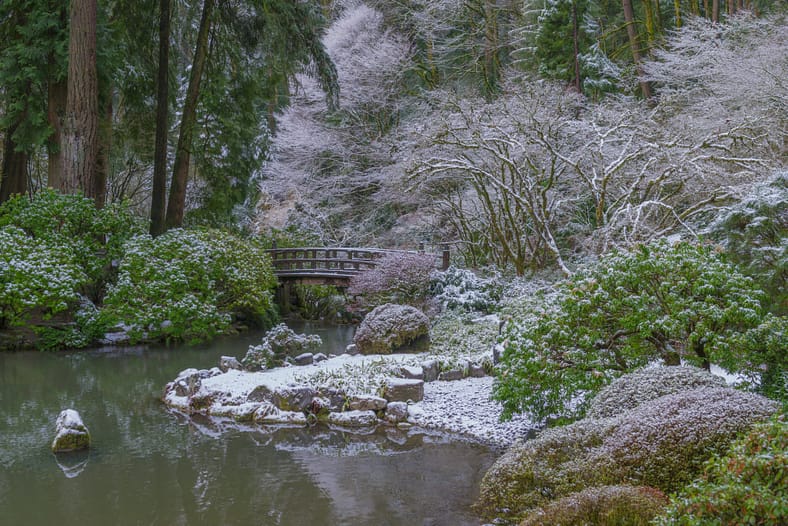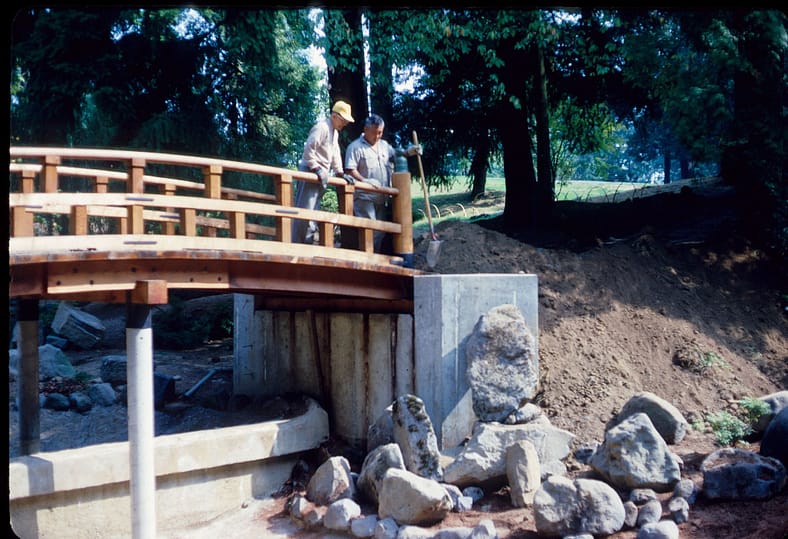
In Portland Japanese Garden’s 60th year, we are sharing stories about the Garden’s history. Among the most beloved features here is our iconic Moon Bridge. When Portland Japanese Garden opened to the public in 1967, the Moon Bridge was installed in the Strolling Pond Garden. Like most bridges in Japanese gardens, it is not a mere conveyance. It is a carefully considered piece of architectural art that introduces new perspectives of the landscape. People who cross it tend to stop and start, double back, and rotate around more than they ever just proceed in a straight line.
The Moon Bridge inspires people to slow down and gaze out in every direction. In doing so, the tranquility of the Garden resonates. The magnetism of the bridge is also what led to its needed replacement. After decades of heavy foot traffic and Pacific Northwest weather, the wear became too great and in the remaining months of the 1980s, Garden leaders determined it had to be replaced. Then-Board Member Tom Mackenzie knew his friend Robert C. Burbank was the man for the job. Visiting Portland Japanese Garden for the first time in several years, Burbank, still lively and vital at age 97, sat down with members of the Garden’s staff to discuss his stunning contribution.

Burbank shared that he and Mackenzie had been longtime collaborators. Both engineers by trade, Burbank had often worked with Mackenzie when Burbank was employed by Jantzen, Inc., a Portland-based apparel company. One day, after Burbank had retired, he was asked to lunch at the Multnomah Club by Mackenzie. Their outing didn’t end there.
“[Tom] said, ‘Now we’re going up to the Japanese Garden, I’ve got a project I want you to look at,’” Burbank recalled. “And I was introduced then to the Japanese bridge. [Tom said,] ‘This is a project. I need it replaced.’ So, I thought about it a bit. And fortunately, Jantzen had just taken down a water storage tank for our dye house, made of solid redwood, heartwood…I got the management of Jantzen to [donate] that wood to the Japanese garden…And that was the start of the bridge.”
The wood, which had been used in a tank that metered out effluent back to the Portland sewer system, had to be sawed down and planed. Planing, a process in which a small amount of wood is shaved off lumber to make it smoother, was to be done at a Vancouver, Washington business. However, when they hit a nail, they refused to do any more for fear of damaging their equipment.

“I had to load up my own little ten-inch planer,” Burbank remembered. “I brought it up to the Garden on my truck and where the [Nezu Gate] is right now is where I set up shop and worked on the lumber for about a week, running it through my planer…I had many interruptions because we were set up right outside the Gate…why, the visitors would stop and say, ‘What’s going on?’ So, I had to explain to them what the project was.”
After laminating the wood into pieces thick enough to be curved, Burbank had them brought to the shop he had set up in his home. “I told Tom it would take me two years because I had a small woodworking business on the side,” Burbank pointed out. “And then I fiddled around about two years in the making to get everything fit together.”
After those two years passed, it was time to bring the new bridge to the Garden. In the fall of 1991, Burbank and Portland Japanese Garden staff tore down the old bridge and replaced it with the new one. Burbank, ever humble when discussing his work, describes it as being a “really easy” process. Perhaps most tasks seem easy when you’ve fought a war.

After hearing about the bombing of Pearl Harbor in 1941, Burbank enlisted with United States Air Force, where he would rise to the rank of first lieutenant. Serving as a bombardier navigator on B-17 aircrafts, Burbank flew dozens of missions over Germany and Europe during World War II.
Hostility towards those of Japanese heritage was a tragic and all-too-common reality in the United States in the years during and after the war. Portland Japanese Garden itself was built with a mindset of cultural diplomacy, in which the experience of cultural exchange could lead to long lasting peace and reignite a friendship between Japan and Portland. Though he was aware of the animosity to Japan, Burbank never harbored it himself.

“I went to Jefferson High School with a Japanese friend, who was the closest friend I had,” Burbank shared. “And he was immediately picked up and shipped to a camp in Idaho, of all places. They were moving [Japanese people] off the coast, for some reason. And I think it was a real injustice to those people who were here, making a good living, supporting a family. And Mitch Matoba was a very dear friend. I’ve never had any animosity towards the Japanese.”
It is poetic that a bridge, a structure that unites different sides, was so ably built by a man who has devoted so much time to his community. Today, the Moon Bridge he built still stands and has been walked over by visitors and guests from every corner of the world. “I have experienced it myself, the calmness that you get when you’re on the bridge,” said Burbank. “The water flowing under you and the koi. It’s just a different world, really. And I think most people get the same feeling.”
“The only parts from the old bridge to the new bridge are the finials on the posts on the end of each handrail,” Burbank continued. “The rest is all new. Guaranteed. It’s been there for, what, 31 years now. And I’m proud of it.”
A Look Back: The First Moon Bridge

The center of the Moon Bridge in Portland Japanese Garden’s Strolling Pond Garden is under a rare patch of open sky. Douglas firs are arranged nearby as though they’ve gathered around a stage. Facing toward the Tea Garden, one can see ripples from the Upper Pond’s waterfall smoothing out on their approach. On the left, water picks up in a faster fashion, dropping and skimming over large stones en route to the Koto-ji lantern.
The iconic scene the Moon Bridge provides belies the fact that its initial design was quite different from the finished product. The bridge may have had a much steeper grade if Professor Takuma Tono, the original designer of Portland Japanese Garden, had not reconsidered his original plans. “…His Moon Bridge was one that was a lot like what they have in San Francisco and other gardens,” William “Robbie” Robinson recounted in a 2010 interview conducted by former Portland Japanese Garden Board of Trustees President Ed McVicker. “[It was] so high that you can’t walk over, you have to crawl over them.”

Robinson, who made innumerous contributions to the construction of Portland Japanese Garden as Head Gardner with the Portland Parks & Recreation Bureau, says that Tono was persuaded to build something gentler on the garden wanderer. “There are bridges in Japan that are not so steep, so he modified it and put in that type of bridge we have here which is easy to cross,” Robinson noted. “The Bridge was built here locally…It was built out of Alaskan cedar which is very similar to cryptomeria in Japan.”
As Burbank noted, the only remaining pieces of the first bridge that are still used today are the four copper giboshi (finials) that are stylized as lotus buds, the flower of Buddha and a symbol of purity.